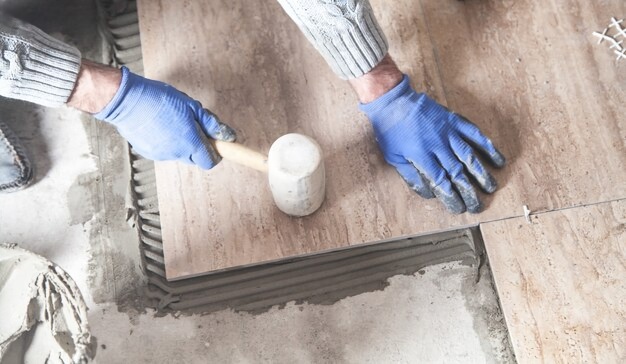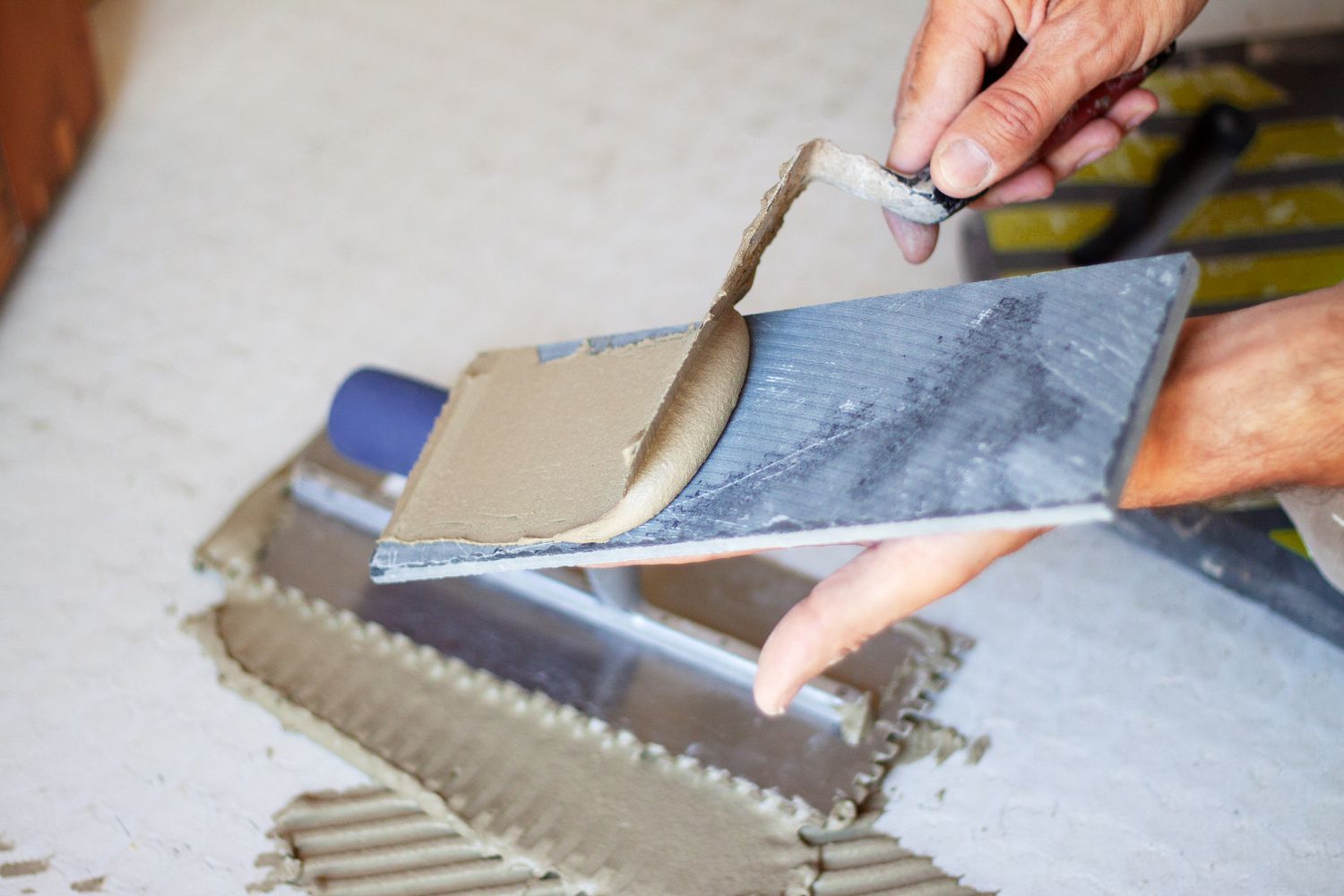Tile adhesive is premixed and ready to use, while thinset mortar needs water before application. Both are used in tile installations for different purposes and surfaces.
Tile adhesive is suitable for non-porous tiles on walls, while thinset mortar is better for floors and wet areas. Understanding the differences between tile adhesive and thinset mortar is crucial for a successful tiling project. Let’s delve deeper into the distinctions between these two materials to help you choose the right one for your specific tiling needs.
By the end of this discussion, you will be able to make an informed decision on whether to use tile adhesive or thinset mortar for your tiling project.
Introduction To Tile Adhesive And Thinset Mortar
Tile adhesive and thinset mortar are two popular materials used to install tiles in various settings. Tile adhesive is a premixed glue that comes in a bucket or tube and is applied directly to the surface, while thinset mortar is a mixture of cement, sand, and additives that needs to be mixed with water before application.
Tile adhesive is typically used for smaller tiles and projects where the surface is clean and level, such as backsplashes or wall tiles. Thinset mortar, on the other hand, is better suited for larger tiles and uneven surfaces, such as floors and shower walls.
| Composition and Uses | Popularity in the DIY Community |
|---|---|
| Tile adhesive is made up of synthetic resins, cement, and other additives. It is used to install tiles on smooth and clean surfaces such as drywall, cement board, or plywood. | Tile adhesive is popular among DIY enthusiasts because it is easy to use and doesn’t require much preparation. It is also less messy than thinset mortar. |
| Thinset mortar is made up of cement, sand, and other additives. It is used to install tiles on uneven surfaces such as concrete or brick. | Thinset mortar is less popular among DIY enthusiasts because it requires more preparation and can be messy. However, it is more durable and can handle heavy traffic areas. |
Key Properties Of Tile Adhesive
When choosing between tile adhesive and thinset mortar, it’s important to consider their key properties. Tile adhesive offers ease of use due to its premixed nature, eliminating the need for mixing with water. On the other hand, thinset mortar requires proper mixing and can be challenging for beginners. In terms of setting time, tile adhesive typically sets faster than thinset mortar, allowing for quicker tile installation. However, thinset mortar offers better versatility and is suitable for a wider range of applications, including outdoor and high-moisture areas. It’s crucial to assess the specific requirements of your tiling project to determine which product aligns best with your needs.
Understanding Thinset Mortar
Thinset mortar is a popular adhesive used for tile installation. It is known for its superior bonding strength, making it ideal for both interior and exterior applications. With its ability to create a strong bond between the tile and the substrate, thinset mortar ensures durability and longevity.
One of the key advantages of thinset mortar is its suitability for wet areas. It is resistant to water and moisture, making it perfect for use in bathrooms, kitchens, and other areas prone to water exposure. This helps prevent the growth of mold and mildew, ensuring a hygienic environment.
There are different types of thinset mortar available, each designed for specific applications. Some variations include modified thinset mortar, which contains additives for improved flexibility and adhesion, and unmodified thinset mortar, which is suitable for standard installations.
In summary, thinset mortar offers exceptional bonding strength, is suitable for wet areas, and comes in various types to cater to different tile installation needs. Choose the right thinset mortar for your project to ensure a successful and long-lasting tile installation.

Application Techniques Compared
Tile adhesive and thinset mortar are both used for tile installation. The troweling methods for application differ between the two. Tile adhesive requires a notch trowel for spreading, while thinset mortar can be applied with a flat trowel. Curing conditions also vary, with tile adhesive typically setting faster than thinset mortar. Proper substrate preparation is crucial for both materials, ensuring a clean, level surface for adhesion. While tile adhesive is suitable for some wall applications, thinset mortar is more versatile, suitable for both walls and floors. Understanding the differences between these two materials is essential for successful tile installations.
Pros And Cons Of Tile Adhesive
Tile adhesive is a great option for quick fixes due to its fast setting time. It is convenient for small projects and repairs. However, it may not be suitable for heavy-duty use or areas with high moisture. On the other hand, thinset mortar is more durable and can withstand heavy traffic and moisture. It provides a strong bond for larger tiles and is ideal for outdoor or wet areas. Nevertheless, it requires longer curing time, making it less convenient for urgent repairs.

The Strengths Of Thinset Mortar
Thinset mortar offers superior bonding strength over tile adhesive, ensuring durable and long-lasting tile installations. Its versatility and ability to withstand moisture make it ideal for various tiling projects. The strength of thinset mortar lies in its reliability and resilience, making it a preferred choice for professionals and DIY enthusiasts alike.
| Thinset Mortar | Tile Adhesive |
| Offers durability in moisture-prone areas. | Suitable for dry indoor applications. |
| Ensures long-lasting tile installations. | May not hold up well in high humidity. |
Cost Comparison And Value
When comparing tile adhesive and thinset mortar, it’s important to consider both the cost and the value they offer. While tile adhesive may be cheaper upfront, thinset mortar provides a stronger bond and greater durability, making it a more cost-effective choice in the long run.
| Price Points | Overall Investment |
| Tile adhesive is generally more expensive upfront. | Thinset mortar offers long-term cost savings due to durability. |
| Initial cost of thinset may be lower than tile adhesive. | Consider future maintenance and repair costs for full picture. |
| Evaluate project scope and budget before deciding. | Factor in installation time and labor costs for best choice. |
Final Verdict: Making The Right Choice
| Tile Adhesive | Thinset Mortar |
| Ready-to-use paste for tiling applications. | Powder to be mixed with water before use. |
| Best for wall tiles and backsplashes. | Ideal for floors and wet areas. |
| Offers quick adhesion, suitable for DIY projects. | Provides strong bond, recommended for heavy tiles. |
For wall projects, Tile Adhesive is convenient, whereas Thinset Mortar is preferable for floor installations and high-moisture areas. Your choice depends on tile weight and surface type.
:max_bytes(150000):strip_icc()/tile-mortar-guide-thinset-mastic-and-epoxy-1821651_hero-3a49ffa14b89485aab8627fd708663b7.jpg)
Frequently Asked Questions
What Is The Difference Between Tile Adhesive And Thinset Mortar?
Tile adhesive is a pre-mixed paste that is used to stick tiles to a surface, while thinset mortar is a mixture of cement, sand, and a bonding agent that is mixed with water before use. Thinset mortar is a stronger adhesive and is recommended for larger tiles and surfaces that will be exposed to moisture.
Can Tile Adhesive Be Used Instead Of Thinset Mortar?
Tile adhesive can be used instead of thinset mortar for small tiles or non-moisture exposed areas. However, for larger tiles or surfaces that will be exposed to moisture, it is recommended to use thinset mortar as it provides better bonding and strength.
How Long Does It Take For Tile Adhesive To Dry?
The drying time for tile adhesive varies depending on factors such as temperature, humidity, and the type of adhesive used. Generally, it takes around 24-48 hours for tile adhesive to fully dry and cure.
How Long Does It Take For Thinset Mortar To Dry?
The drying time for thinset mortar also varies depending on factors such as temperature, humidity, and the type of thinset used. Generally, it takes around 24-48 hours for thinset mortar to fully dry and cure.
Conclusion
The choice between tile adhesive and thinset mortar ultimately depends on your specific tiling project. While tile adhesive offers convenience and ease of use for smaller, less demanding applications, thinset mortar provides superior bonding strength and durability for larger, more complex projects.
Consider factors such as tile type, substrate, and environmental conditions to make an informed decision. Ultimately, selecting the right product will ensure a successful and long-lasting tile installation.

